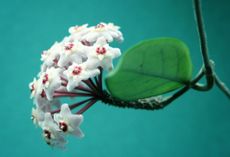Hoya Plant Feeding: How To Fertilize Wax Plants


Wax plants make terrific houseplants. These easy-care plants have few special needs, but they do like to be fed. Hoya growth will take off if you have a regular feeding schedule. There are two schools of thought on when to stop fertilizing a wax plant, but almost everyone agrees they need supplemental food during the growing season. Find out when to fertilize wax plants and enjoy these indoor beauties for years.
When to Fertilize Wax Plants
Hoyas most likely originated in India. There are at least 100 species, many of which produce marvelous bloom clusters. Most growers find them to be unfussy little plants that simply need average light, warm interior temperatures, and regular water. The best performance can be achieved with a regular feeding program. This will fuel growth, enhance health, and increase the chances of some of the beautiful blooms. Hoya fertilization can take place year-round. However, many growers feel the plant should not be fed at all in winter, while others do a half dose of liquid fertilizer in the cold season. Feeding the plant in winter may cause an excess buildup of salt in the soil, so if you do feed then, make sure you leach soil occasionally. A liquid-based plant food is most typically recommended for fertilizing a wax plant. It is easy to apply and gets right to the roots where the plant can uptake nutrients. Once per month add the food to the irrigation water and apply to the soil around the roots. Time release granules are an excellent choice for Hoya plant feeding. They will slowly add nutrients to soil, so you don't have to remember to fertilize for months.
Nutrients for Hoya Plant Feeding
The nutrient ratio listed on the plant food should have a higher nitrogen content since Hoyas are primarily foliage plants. Any food with a 2:1:2 or 3:1:2 is sufficient to keep the plant in good health. For wax plants that are flowering, however, switch to a 5:10:3 with a high phosphorus number to encourage blooming. Use a high phosphate fertilizer for two months prior to the plant's normal blooming time. That will fuel the plant to produce more profuse and larger blooms. Once flowering starts, go back to the high nitrogen food. Plants that are in low light areas will typically need half the food as those in full, indirect light.
How to Fertilize Wax Plants
Choice of feed and timing are important, but you still need to know how to fertilize wax plants. Most fertilizers will give instructions on the amount to mix with water or to add to soil if using a granular preparation. Professional growers recommend a rate of 2.9 pounds (1.32 kg.) of nitrogen per 1,000 square feet (92.9 sq. m.) but that isn't helpful if you just have a couple of plants. Liquid foods often have a measuring device to show how much to add to a gallon of water. Granular foods will also have a method of measuring. If all else fails, consult the back of the product and it will tell you how many units per gallon to mix. Deeply water in any liquid food and also water deeply when using a granular time release formula. This gets food right to the roots but helps prevent buildup in the soil, which can harm the plant's health.
Gardening tips, videos, info and more delivered right to your inbox!
Sign up for the Gardening Know How newsletter today and receive a free download of our most popular eBook "How to Grow Delicious Tomatoes."

Bonnie Grant is a professional landscaper with a Certification in Urban Gardening. She has been gardening and writing for 15 years. A former professional chef, she has a passion for edible landscaping.
-
 Urban Beekeeping Guide: Top Tips For Raising Bees In The City
Urban Beekeeping Guide: Top Tips For Raising Bees In The CityUrban beekeeping can be a rewarding and appreciated pastime, but first be sure it’s legal in your city and learn the ropes of beekeeping.
By Mary Ellen Ellis
-
 2024 Plant Of The Year: Why Experts Say Philodendron Is The “It” Plant Of The Year
2024 Plant Of The Year: Why Experts Say Philodendron Is The “It” Plant Of The YearWe aren’t surprised that philodendron was designated the plant of the year. Versatile, easy-care and lovely, it’s the houseplant of the year 2024!
By Bonnie L. Grant
-
 Hoya Propagation Methods – Tips For Propagating Hoyas
Hoya Propagation Methods – Tips For Propagating HoyasIf you?re interested in wax plant propagation, the most dependable technique is propagation via stem cuttings. Hoya propagation through seed is chancy and the resulting plant likely won?t be true to the parent plant - if the seed germinates at all. Learn more here.
By Mary H. Dyer
-
 No Flowers On Hoya Plant: How To Get Wax Plant To Bloom
No Flowers On Hoya Plant: How To Get Wax Plant To BloomIf there are no flowers on Hoya, it may be that you have one of the non-blooming types or (more likely) some cultural defect is causing the plant to fail to flower. Click this article to find out how to get wax plants to bloom and keep them flowering for years to come.
By Bonnie L. Grant
-
 Wax Plant Care: Tips On Growing Hoya Vines
Wax Plant Care: Tips On Growing Hoya VinesHoya wax vines are long-lived plants that prefer cramped growing conditions. With a little attention and knowledge on how to care for Hoya, these plants can be passed down from generation to generation. Click this article to learn more.
By Bonnie L. Grant